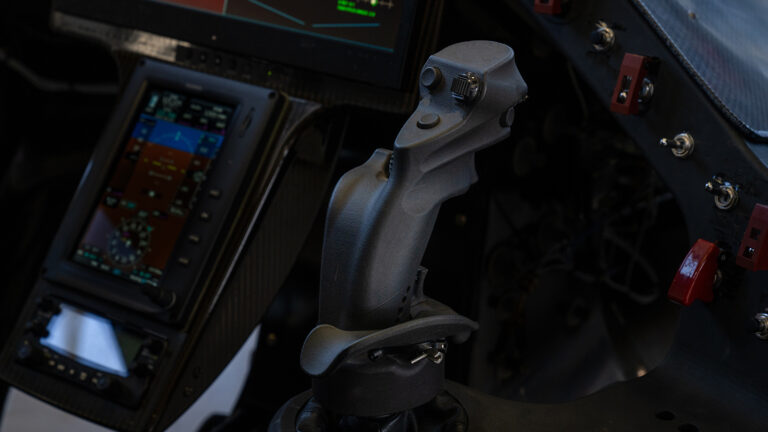Stay Up to Date
Submit your email address to receive the latest industry and Aerospace America news.
Joby: ‘Unified control’ reduces pilot workload
It’s no coincidence that electric aircraft developer Joby Aviation employs two test pilots with years of flight experience in the F-35B which, like Joby’s S4 air taxi, can transition between vertical and wingborne forward flight.
Joby drew inspiration for the S4 from the Joint Strike Fighter’s unified control technology, in which the pilot manipulates a single set of controls to send commands to a computer that rotates the engine nozzle.
These unified controls are in contrast to the initial version of the British-developed Harrier jets, which had a separate stick to pivot its nozzles, a control design that sometimes led to pilot confusion, says Gregory Bowles, Joby’s head of government affairs. In the S4, unlike helicopters, there is no need for pedals on the floor to counter torque and maintain trim, where the nose is pointing in relation to heading, since the Joby aircraft does that automatically.
“We want our pilots to be able to focus on weather and airmanship versus stick and rudder skills,” Bowles explains. “Our software is of course specific to Joby, but the concept of unified flight controls was developed through the F-35B program.”
In the S4, the left inceptor is a throttle that controls how fast the aircraft moves in vertical or horizontal flight by sending commands to flight control computers that adjust the speed of the rotors. The right inceptor is a stick that controls attitude and direction.
If the pilot lets go entirely, the software is designed to bring the aircraft to a stable hover. The S4 also has a shortcut button to initiate a hover over a landing zone.
Bowles explains that the S4 flight control software automatically prevents pilots from doing anything outside a safe flight envelope that could damage the aircraft or put it in a stall spin.
“If you try to do that, decelerate and make an uncoordinated turn, it won’t let you do that,” he says.
For a little more perspective on the controls, I spoke with someone who has flown the S4 remotely: retired U.S. Air Force Col. George “Hank” Griffiths, who is now chief of test and airworthiness for the Air Force’s AFWERX innovation program. He’s also flown the F-35B, and I caught up with him last month at Edwards Air Force Base when he was there to see the first delivery of an S4 for test flights at the base.
“If I’m in a hover state and I want to go down, I just push forward [on the throttle] and what happens is the flight control laws reduce the RPMs in the motors and the flight translates down,” Griffiths said. “In the Harrier, how they did it was to reduce the power and move the nozzles, which was a higher workload.”
Get the latest news about advanced air mobility delivered to your inbox every two weeks.
About paul brinkmann
Paul covers advanced air mobility, space launches and more for our website and the quarterly magazine. Paul joined us in 2022 and is based near Kennedy Space Center in Florida. He previously covered aerospace for United Press International and the Orlando Sentinel.
Related Posts
Stay Up to Date
Submit your email address to receive the latest industry and Aerospace America news.




